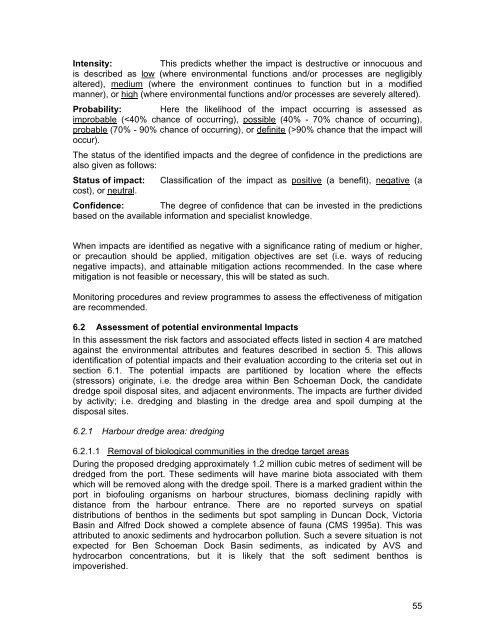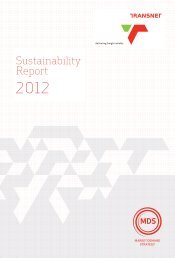BEN SCHOEMAN DOCK BERTH DEEPENING Specialist ... - Transnet
BEN SCHOEMAN DOCK BERTH DEEPENING Specialist ... - Transnet
BEN SCHOEMAN DOCK BERTH DEEPENING Specialist ... - Transnet
You also want an ePaper? Increase the reach of your titles
YUMPU automatically turns print PDFs into web optimized ePapers that Google loves.
Intensity:<br />
This predicts whether the impact is destructive or innocuous and<br />
is described as low (where environmental functions and/or processes are negligibly<br />
altered), medium (where the environment continues to function but in a modified<br />
manner), or high (where environmental functions and/or processes are severely altered).<br />
Probability: Here the likelihood of the impact occurring is assessed as<br />
improbable (90% chance that the impact will<br />
occur).<br />
The status of the identified impacts and the degree of confidence in the predictions are<br />
also given as follows:<br />
Status of impact: Classification of the impact as positive (a benefit), negative (a<br />
cost), or neutral.<br />
Confidence: The degree of confidence that can be invested in the predictions<br />
based on the available information and specialist knowledge.<br />
When impacts are identified as negative with a significance rating of medium or higher,<br />
or precaution should be applied, mitigation objectives are set (i.e. ways of reducing<br />
negative impacts), and attainable mitigation actions recommended. In the case where<br />
mitigation is not feasible or necessary, this will be stated as such.<br />
Monitoring procedures and review programmes to assess the effectiveness of mitigation<br />
are recommended.<br />
6.2 Assessment of potential environmental Impacts<br />
In this assessment the risk factors and associated effects listed in section 4 are matched<br />
against the environmental attributes and features described in section 5. This allows<br />
identification of potential impacts and their evaluation according to the criteria set out in<br />
section 6.1. The potential impacts are partitioned by location where the effects<br />
(stressors) originate, i.e. the dredge area within Ben Schoeman Dock, the candidate<br />
dredge spoil disposal sites, and adjacent environments. The impacts are further divided<br />
by activity; i.e. dredging and blasting in the dredge area and spoil dumping at the<br />
disposal sites.<br />
6.2.1 Harbour dredge area: dredging<br />
6.2.1.1 Removal of biological communities in the dredge target areas<br />
During the proposed dredging approximately 1.2 million cubic metres of sediment will be<br />
dredged from the port. These sediments will have marine biota associated with them<br />
which will be removed along with the dredge spoil. There is a marked gradient within the<br />
port in biofouling organisms on harbour structures, biomass declining rapidly with<br />
distance from the harbour entrance. There are no reported surveys on spatial<br />
distributions of benthos in the sediments but spot sampling in Duncan Dock, Victoria<br />
Basin and Alfred Dock showed a complete absence of fauna (CMS 1995a). This was<br />
attributed to anoxic sediments and hydrocarbon pollution. Such a severe situation is not<br />
expected for Ben Schoeman Dock Basin sediments, as indicated by AVS and<br />
hydrocarbon concentrations, but it is likely that the soft sediment benthos is<br />
impoverished.<br />
55

















